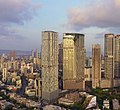The US FDA’s proposed rule on laboratory-developed tests: Impacts on clinical laboratory testing
Contents
Parel
Paraḷ | |
|---|---|
Neighbourhood | |
 A view of Lower Parel's skyline | |
| Coordinates: 18°59′N 72°50′E / 18.99°N 72.84°E | |
| Country | India |
| State | Maharashtra |
| District | Mumbai City |
| City | Mumbai |
| Demonym(s) | Parelkar, Paralkar |
| Language | |
| • Official | Marathi |
| Time zone | UTC+5:30 (IST) |
| PIN | 400012[1] |
| Area code | 022 |
| Civic agency | BMC |
| Lok Sabha constituency | Mumbai South |
| Vidhan Sabha constituency | Worli Shivadi |
Parel (ISO: Paraḷ, pronunciation: [pəɾəɭ]) is a neighbourhood of Mumbai.[2] Parel used to have a number of textile mills, but these have been replaced by commercial office space development.[3]
History

Originally, Parel was a separate island, one of the Seven Islands of Bombay.
The Parel Relief or (Parel Shiva) is an important monolithic relief of the Hindu god Shiva in seven forms that is dated back to the late Gupta period, in the 5th or 6th century AD by the ASI. It was found in Parel when a road was being constructed in 1931, and moved to the nearby Baradevi Temple, where it remains in worship, in its own room.[4] The name Parel has its roots from the Parali Vaijanath Mahadev temple dedicated to Lord Shiva.[5]
An inscription dated 26 January 1187 (Paurnima of Magha, Saka 1108) is found there recording of a grant made by Shilahara king Aparaditya II out of the proceeds of an orchard in a village named Mahavali (close to Kurla) for a Vaidyanatha temple.[6]
In 1771 William Hornby, the Governor of Bombay, moved into the former friary, which became known as Government House, and a number of mills were subsequently established nearby.[7] In 1883, the Governor's wife died of cholera in the house and two years later, the Governor's Mansion was moved to Malabar Point. During the plague epidemics of the 1890s, the old Government House was leased to the newly founded Haffkine Institute.[8]
It was a district in Girangaon, which was the focus of the Great Bombay textile strike of 1982.[9]
Politics
It was a Vidhan Sabha constituency of Maharashtra from 1962[10] to 2004.[11] It was constituted into Shivadi constituency by the Delimitation of Parliament and Assembly Constituencies Order of 2008.[12]
Gallery
-
Motilal Oswal building
-
An aerial view of Lower Parel
-
Phoenix Mills chimney
References
- ^ "Pin code : Parel, Mumbai". indiapincodes.net. Retrieved 10 February 2021.
- ^ D'Cunha, Jose Gerson (1900). "IV The Portuguese Period". The Origins of Bombay (3 ed.). Bombay: Asian Educational Services. p. 265. ISBN 81-206-0815-1. Retrieved 4 January 2009.
- ^ Kailash Babar (9 May 2012). "Mumbai's Lower Parel: One of the most coveted piece of real estate in the country's financial capital hard to sell". The Economic Times. The Times Group. Retrieved 10 December 2016.
- ^ ASI; Michell, 355
- ^ "Parel belonged to the 13th Century, from another shrine to shiva". www.geni.org. Retrieved 2 July 2020.
- ^ Corpus Inscriptions Indicarum, Vol. 6, p. 161-162. https://archive.org/stream/corpusinscriptio014678mbp#page/n391/mode/2up
- ^ "Government House, Parell [Parel, Bombay]". British Library. Retrieved 9 May 2019.
- ^ Hanhart, Joël (2016). Waldemar Mordekhaï Haffkine (1860-1930). Biographie intellectuelle. Paris: Éditions Honoré Champion.
- ^ Death of an Industrial City: Testimonies of Life Around Bombay Textile Strike of 1982 Indian Labour Archives Archived 6 May 2006 at the Wayback Machine
- ^ "STATISTICAL REPORT ON GENERAL ELECTION, 1962 TO THE LEGISLATIVE ASSEMBLY OF MAHARASHTRA" (PDF). Archived from the original (PDF) on 17 April 2018. Retrieved 24 April 2018.
- ^ "STATISTICAL REPORT ON GENERAL ELECTION, 2004 TO THE LEGISLATIVE ASSEMBLY OF MAHARASHTRA" (PDF).
- ^ "DELIMITATION OF PARLIAMENTARY AND ASSEMBLY CONSTITUENCIES ORDER, 2008" (PDF). Archived from the original (PDF) on 3 October 2018. Retrieved 24 April 2018.
Further reading
- Michell, George (1990), The Penguin Guide to the Monuments of India, Volume 1: Buddhist, Jain, Hindu, 1990, Penguin Books, ISBN 0140081445
- Star Track; Times of India Mumbai; pg-2; 21 April 2006


























